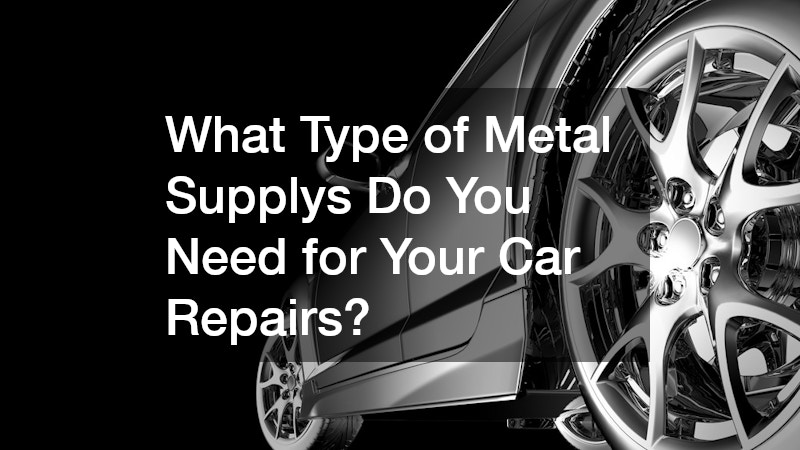Keeping your vehicle in top condition means choosing the right materials for the job. Whether you’re handling minor fixes or tackling a more extensive restoration, the quality and type of metal supplys you use can make all the difference. From panel replacements to structural reinforcements, selecting suitable metals ensures safety, durability and a professional finish.
In this article, we’ll cover the most common metal types used in automotive repair, explain their benefits and help you make informed decisions when sourcing materials for your next project.
Why Metal Matters in Automotive Repairs
Vehicles are built with a combination of metals, each chosen for specific functions. When repairs are necessary, using the right replacement materials isn’t just about appearance – it’s about ensuring your car remains roadworthy and safe.
Different parts of a car endure varying levels of stress. The underbody, chassis and crumple zones require metals with specific strength and flexibility characteristics. On the other hand, cosmetic repairs to panels or trims often call for metals that are easier to shape and weld.
Using incorrect materials can compromise structural integrity, affect paintwork adhesion or cause corrosion over time. That’s why understanding metal supplys and their applications is essential for any repair job.
Common Types of Automotive Metals
Mild steel is among the most widely used metals in car manufacturing and repair. Its affordability, weldability and durability make it ideal for body panels, wheel arches and subframes. Mild steel can handle the day-to-day wear a car faces while remaining relatively easy to shape and manipulate.
High-strength steel is a step up in performance. Found in critical structural areas like pillars and chassis rails, this metal offers more resistance to impact while remaining lighter than mild steel. However, it’s harder to cut and weld, often requiring specialised tools and techniques.
Aluminium is increasingly used in modern vehicles to reduce overall weight and improve fuel efficiency. It’s commonly found in bonnets, doors and suspension components. Aluminium resists rust and is highly recyclable, but it’s more prone to dents and requires different repair methods compared to steel.
Stainless steel is sometimes used in performance exhaust systems and decorative trims. It offers high resistance to rust and high temperatures but can be more costly. If you’re working on a custom job or performance build, stainless steel might be one of the more specialised metals you’ll need.
Galvanised steel is mild steel coated with zinc to prevent corrosion. This is especially important for parts exposed to moisture or road salt, such as undercarriage components and wheel wells. It offers a longer lifespan for repairs in high-wear areas.
How to Choose the Right Metal for Your Repair
The first step is identifying the exact area and nature of the repair. Structural repairs require stronger, safety-rated materials. Cosmetic or superficial damage may allow more flexibility in choosing metals.
Next, consider compatibility with existing materials. Welding two dissimilar metals can lead to galvanic corrosion, which significantly shortens the lifespan of the repair. Ideally, you want to match the new metal as closely as possible to the original.
Finally, factor in your tools and skill level. Working with high-strength steel or aluminium may require equipment and knowledge that’s different from handling standard steel. If you’re a DIY enthusiast, it might be better to start with easier-to-work materials and gradually take on more advanced jobs.
Where to Source Quality Metal Supplys in Australia
Whether you’re a panel beater, hobbyist or full-time mechanic, sourcing your materials from a reliable supplier is critical. Look for businesses that offer automotive-grade metals and can provide cut-to-size options. Local metal yards, online retailers and auto body specialists often have dedicated sections for car repair materials.
In regional areas, delivery options may be more important. Check whether the supplier offers fast shipping or in-store pickup and compare prices for bulk orders if you’re doing a full restoration or working on multiple vehicles.
The Future of Metals in Car Repairs
With car designs evolving, so too are the materials used in production. Lightweight, high-performance metals like boron steel and carbon fibre alloys are becoming more common in newer vehicles. While these materials offer advanced safety and efficiency benefits, they also introduce more complexity in repair methods.
Electric vehicles, for example, rely heavily on aluminium and specialised metals for their frames and battery casings. As these cars become more common, repairers will need to adapt their sourcing and skills to accommodate new standards.
Choosing the right metal for your car repairs is more than a technical decision – it’s an investment in quality, safety and performance. By understanding the different types of metals and their best-use scenarios, you can approach your repairs with confidence. Whether you’re replacing a panel, reinforcing a chassis or customising your vehicle, the right materials make all the difference.
.

